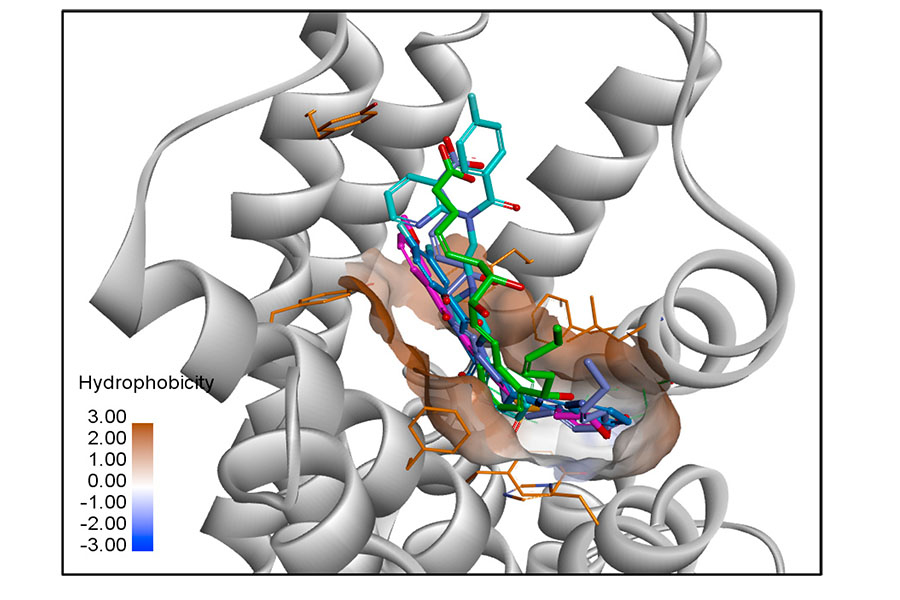Brigham and Women’s Hospital and NCATS Scientists Dial Up an Approach Against Out-of-Control Inflammation
March 22, 2019
Inflammation is an important part of the immune system’s response to injury and infection. It signals the body to heal and repair damaged tissue and defend itself against invaders such as viruses and bacteria.
Normally, inflammation is temporary; the body has a process to halt it. But when the process breaks down because of an aging immune system, genetic disorder, or other cause, inflammation can become chronic and can contribute to diseases, including some cancers, heart disease, rheumatoid arthritis and neurodegenerative disorders.
Current anti-inflammatory drugs mostly target the chemical trigger that prompts inflammation to begin or increase. But NCATS scientists, working with investigators at Brigham and Women’s Hospital in Boston, are investigating a different strategy to fight inflammation. Instead of attacking what sets it off, they are trying to take advantage of the body’s ability to quiet it down. The scientists have identified compounds that can mimic the activity of chemicals called resolvins, which step up the body’s natural ability to regulate inflammation. The findings, reported in Cell Chemical Biology, open the door to a potential new approach to treat out-of-control inflammation.
Resolvins reduce inflammation by reducing the activity of immune system cells that are called into action by infection or injury. Scientists think that mimicking the effects of resolvins might be useful in treating excessive inflammation and the diseases it can cause. But producing compounds that can mimic these effects has been difficult. Resolvins have complicated, unstable chemical structures and are short-lived; they exist only to shut down inflammation, and then they disappear.
About six years ago, NCATS scientists Marc Ferrer, Ph.D., Noel Southall, Ph.D., and Juan Marugan, Ph.D., began collaborating with Charles Serhan, Ph.D., D.Sc., director of the Center for Experimental Therapeutics and Reperfusion Injury at Brigham and Women’s Hospital. Serhan was studying resolvins and similar substances that had comparable effects to reduce inflammation. Serhan and colleagues first discovered resolvins in 2002. Since then, his lab has advanced much of the understanding of the way resolvins work on immune cells through chemical docking stations called receptors. This interaction sends out a flood of chemical signals telling the immune system to stand down and naturally reduce inflammation.

Human resolvin receptor shown with several attached molecules represented in green, blue, red, cyan, violet and magenta. Each can potentially turn on anti-inflammatory activity.
Serhan found that a type of resolvin called resolvin D1 reduced inflammation in the nervous system and worked through a protein, GPR32, which is a receptor type called a G protein-coupled receptor. Other types of resolvins work through different receptors. Harnessing the body’s ability to control neurological inflammation could help treat spinal injury, stroke and Alzheimer’s disease.
“It’s very appealing,” said Ferrer. “For neurological disorders, such as spinal injury or stroke, inflammation makes the neurological damage worse. We want to explore how controlling its resolution can help with disease treatment.
At the same time, a better understanding of resolvins was needed.
Serhan approached NCATS for help finding other molecules that were more stable than resolvins but could carry out the same function. Ferrer, Southall, Marugan and their NCATS colleagues used a technique called high-throughput screening to sort through more than 48,000 candidate compounds at the same time. The screening used a series of tests to look for molecules that could activate human GPR32.
The team identified four compounds that had the most potential to turn on the body’s mechanism to reduce inflammation. Two are known molecules, and the other two have novel chemical structures. Serhan and his colleagues confirmed the anti-inflammatory and inflammation-resolving activity of the compounds in separate tests.
“It’s the first time anyone has had synthetic molecules that could potentially modulate this receptor,” Marugan said, adding that the findings have helped explain the effects of resolvins and similar molecules. “This provides an opportunity to develop a new kind of drug to reduce inflammation.”
According to Marugan, the work established an approach that researchers can use to discover and develop better candidate drugs more efficiently. At the same time, studying molecules that can reduce inflammation allows NCATS scientists to gain a better understanding of the intricate relationship between inflammation and the immune system.
“The next step would be for medicinal chemists to further optimize and make these four molecules more specific, potent and drug-like,” Marugan said. “These molecules are starting points for drugs, and further testing will be needed.”
The Brigham-NCATS group would still like to better understand the molecular bases of how GPR32 interacts with resolvins and other chemicals and how this interaction affects the chemical cues sent to immune cells to halt inflammation.


